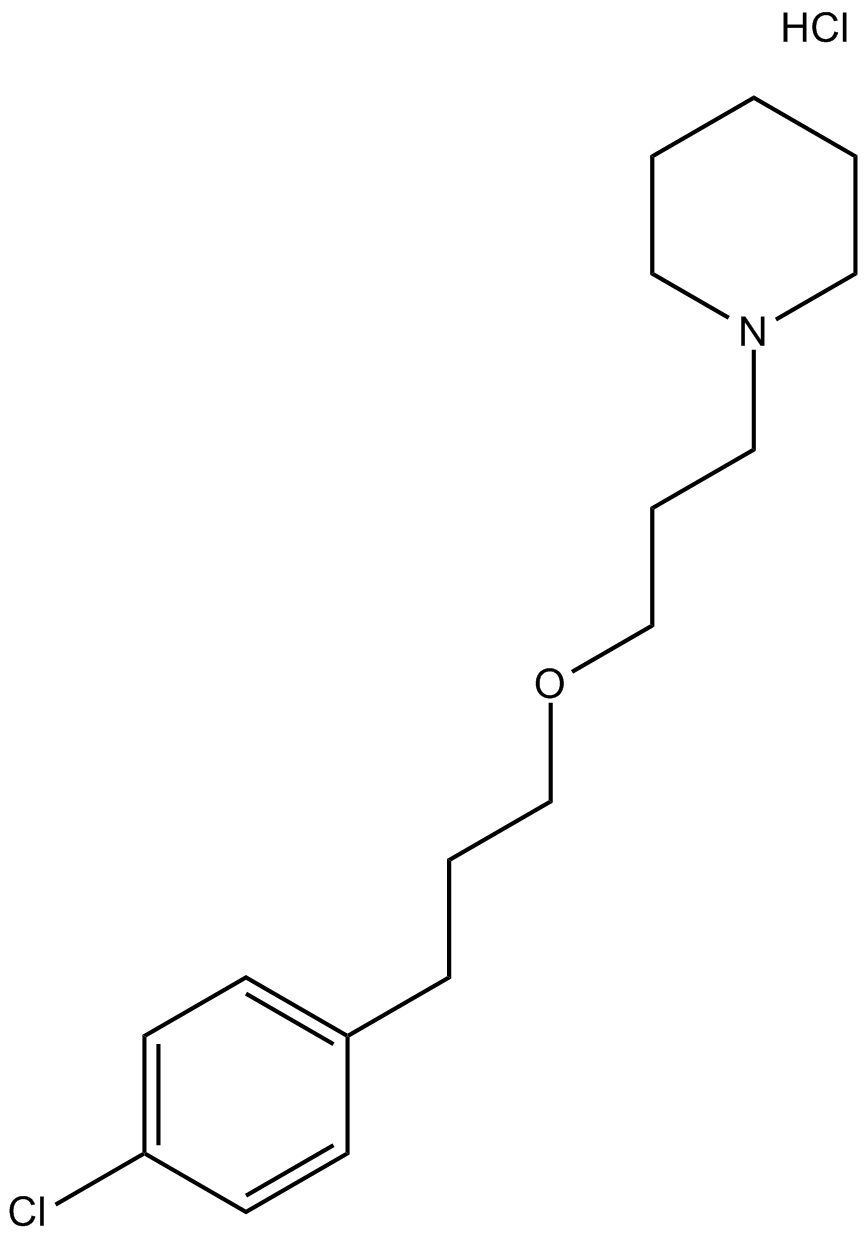Pitolisant hydrochloride (Synonyms: BF 2649) |
| カタログ番号GC11382 |
ヒスタミンH3受容体拮抗薬および逆作動薬
Products are for research use only. Not for human use. We do not sell to patients.

Cas No.: 903576-44-3
Sample solution is provided at 25 µL, 10mM.
Pitolisant HCl (BF2.649; Ciproxidine) is a potent, novel, and selective nonimidazole inverse agonist at the recombinant human H3 receptor with a Ki value of 0.16 nM[1]. The histamine H3 receptor, a histamine autoreceptor, functions as a heteroreceptor that regulates the release of other neurotransmitters, making it an attractive drug target for a number of indications including cognition [2].
In vitro: BF2.649 behaved as a competitive antagonist with a Ki value of 0.16 nM. BF2.649 functioned as an inverse agonist with an EC50 value of 1.5 nM and an intrinsic activity about 50% higher than that of ciproxifan. Pitolisant in vitro potency was approximately 6 times lower at the rodent receptor [1].
In vivo: Pitolisant HCl was an oral bioavailable agonist. In mice, after oral and i.v. administrations of pitolisant HCl, the ratio of plasma areas under the curve was 84%. BF2.649 enhanced tele-methylhistamine levels in mouse brain, an index of histaminergic neuron activity in a dose dependent manner with an ED50 value of 1.6 mg/kg p.o. The response persisted after repeated administrations for 17 days [1]. Treatment with 20-, 40-, or 60-mg doses of pitolisant showed a statistically significant suppressive effect (standardized photosensitive response [SPR] reduction as measured with paired t-tests) in 9/14 (64%) patients of whom 6/14 (43%) showed abolition of the response to intermittent photic stimulation (IPS) [3]. BF2.649 showed significant inhibitory activity in several mouse models of schizophrenia [4].
References:
[1] Ligneau X, Perrin D, Landais L, Camelin JC, Calmels TP, et al, BF2. 649 [1-{3-[3-(4-Chlorophenyl)propoxy]propyl}piperidine, hydrochloride], a nonimidazole inverse agonist/antagonist at the human histamine H3 receptor: Preclinical pharmacology. J Pharmacol Exp Ther.2007 Jan;320(1):365-75.
[2] T A Esbenshade, K E Browman, R S Bitner, M Strakhova, M D Cowart, J D Brioni The histamine H3 receptor: an attractive target for the treatment of cognitive disorders. Br J Pharmacol. 2008 Jul; 154(6): 1166–1181.
[3] Kasteleijn-Nolst Trenité D, Parain D, Genton P, Masnou P, Schwartz JC, Hirsch E. Efficacy of the histamine 3 receptor (H3R) antagonist pitolisant (formerly known as tiprolisant; BF2.649) in epilepsy: dose-dependent effects in the human photosensitivity model. Epilepsy Behav.2013 Jul;28(1):66-70.
[4] Ligneau X, Landais L, Perrin D, Piriou J, Uguen M, Denis E, Robert P, Parmentier R, Anaclet C, Lin JS, Burban A, Arrang JM,Schwartz JC. Brain histamine and schizophrenia: potential therapeutic applications of H3-receptor inverse agonists studied with BF2.649. Biochem Pharmacol. 2007 Apr 15;73(8):1215-24. a
Average Rating: 5 (Based on Reviews and 30 reference(s) in Google Scholar.)
GLPBIO products are for RESEARCH USE ONLY. Please make sure your review or question is research based.
Required fields are marked with *




















